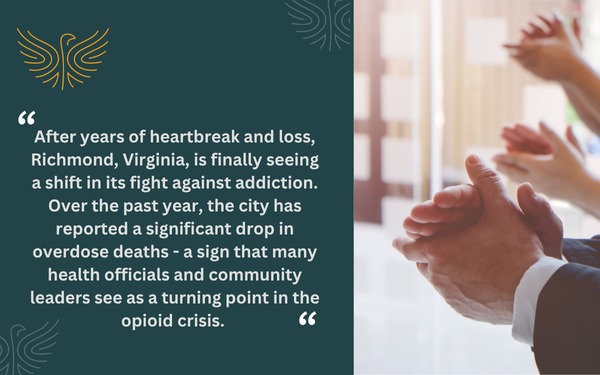After years of heartbreak and loss, Richmond, Virginia, is finally seeing a shift in its fight against addiction. Over the past year, the city has reported a significant drop in overdose deaths - a sign that many health officials and community leaders see as a turning point in the opioid crisis.
Learn more about Richmond VA Overdose and Addiction Statistics
For families who’ve lived through unimaginable grief and for a community that’s poured everything into this fight, these declining numbers represent lives saved, hope renewed, and the first signs of real and lasting healing. And as many know, it’s taken work to get here.
In the last few years, there have been various efforts in Richmond, Virginia, to increase access to treatment and improve harm reduction strategies. Below, we take a closer look at what’s driving this change - and how local treatment centers play an important role in this shift.

_______________________________________________________
Does Virginia Have an Opioid Problem?
Between 1997 and 2003, rural western Virginia saw a staggering 300% increase in overdose deaths, marking the early signs of what would become a nationwide epidemic.
Over the next few decades, the situation got much worse. In recent years, Richmond, in particular, has found itself at the center of Virginia’s opioid crisis. Between 2019 and 2023, fatal opioid overdoses in the city surged from 60 to roughly 297 - a nearly 400% increase. The vast majority of these deaths, around 90%, involved fentanyl or related synthetic opioids.
However, there’s been a recent shift in these trends, renewing hope for residents and loved ones.
_______________________________________________________
Recent Statistics & What They Show
According to newly released CDC data, there’s been a 38.5% drop in drug overdose deaths in Virginia. In fact, recent data shows that overdose deaths are down across the nation.
In Richmond, where overdose deaths have risen sharply in recent years, this decline offers a glimmer of hope. From just 60 opioid-related fatalities in 2019 to nearly 300 in 2023, the city has seen the devastating impact of the crisis firsthand. Roughly 9 out of 10 overdose deaths in Richmond involve fentanyl or similar opioids.
Yet, this new data suggests a potential turning point. While the city has been one of the hardest hit in the state, Richmond may finally be seeing the early effects of expanded recovery programs, harm reduction strategies, and increased public awareness. If this momentum continues, it could mark the beginning of a broader shift toward recovery—not just for Richmond but for communities across Virginia and the United States.
Why Are Overdose Deaths Declining?
Recovery advocates point to several key factors behind the recent drop in overdose deaths. Increased funding for sober living homes and recovery services, expanded Medicaid coverage for substance use treatment, and the growing availability of peer recovery support have all played a role. Widespread access to Narcan (naloxone), a medication that can reverse opioid overdoses, has also been a major contributor.
While the progress is promising, experts caution that the fight isn’t over. Richmond remains one of the hardest-hit areas in Virginia. To keep moving forward, ongoing investment in treatment, prevention, and harm reduction efforts is essential.
Remaining Challenges
While Virginia’s dramatic decline in overdose deaths offers hope, the underlying crisis of addiction remains far from resolved. The potency and unpredictability of fentanyl mean that even as fewer people are dying, those who use drugs face persistent dangers.
Beyond the immediate danger of overdose, many challenges to long-term recovery still exist. For instance, stigma around mental health and addiction continues to prevent people from reaching out for help. In rural and underserved communities, access to quality treatment and rehabilitation services remains limited. The financial burden of addiction is still heavy, and countless families are left navigating the lasting emotional and economic toll of a loved one’s substance use.
Additionally, overdose continues to be the number one cause of death for Americans between 18 and 44, despite overall improvements. In other words, the fight against opioids and drug use still requires a sustained commitment, continued funding for treatment, and compassionate care—there’s still much to be done.
_______________________________________________________
Why There’s Still Hope
Virginia’s progress shows what’s possible when communities come together. The momentum we’re seeing across Richmond and throughout the state is proof that addiction doesn’t have to define a life—it’s a treatable condition, and recovery is not only possible, it’s happening every single day.
This kind of progress wouldn’t be possible without the people on the front lines, including first responders who act quickly to save lives, healthcare providers, families who hold onto hope, and community partners. Rehab facilities also play a vital role in this shift. Centers, like Freedom Recovery Centers (FRC), offer structure, counseling, peer support, and long-term treatment plans that address both the physical and emotional aspects of addiction. The truth is that recovery is possible, and it all starts with a single step.
If you or a loved one is struggling with addiction, the FRC team is here to help guide you toward a healthier and fulfilling life. Call us at 804-635-3746 or fill out our online form.
.svg)






.svg)

.svg)



.svg)
